
| VIDEO |
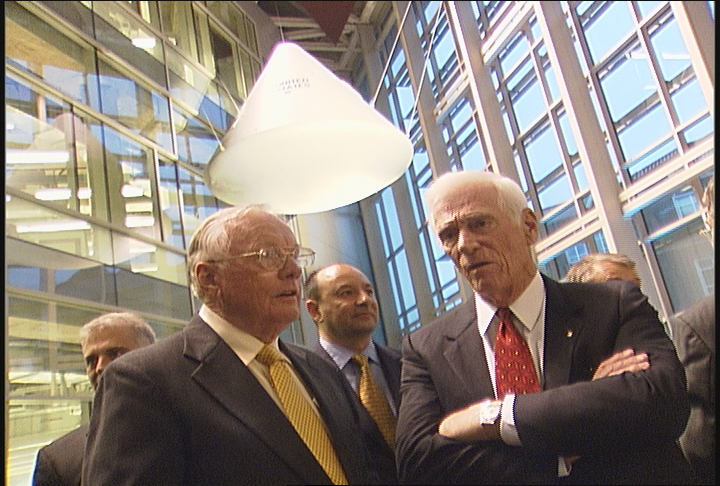 * Purdue hails alumnus Neil Armstrong as it dedicates
the new engineering building bearing his name. (4 minutes, 7 seconds) * Purdue hails alumnus Neil Armstrong as it dedicates
the new engineering building bearing his name. (4 minutes, 7 seconds) |
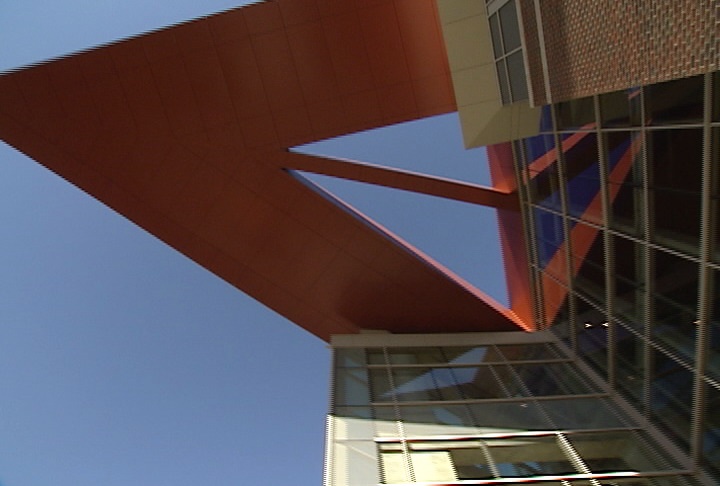 * Leah Jamieson, Dean of Engineering, discusses the importance of the new Neil Armstrong Hall of Engineering. (3 minutes, 46 seconds) * Leah Jamieson, Dean of Engineering, discusses the importance of the new Neil Armstrong Hall of Engineering. (3 minutes, 46 seconds) |
| * Armstrong Hall dedication Webcast |
| RELATED NEWS RELEASES |
| * Neil Armstrong sculpture, lunar footprints, to be unveiled at Purdue |
| * Donors, alumni played major role in funding Neil Armstrong Hall |

October 27, 2007
Neil Armstrong Hall is new home to Purdue engineering
WEST LAFAYETTE, Ind. -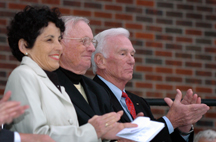 |
"Purdue engineering has long been a place for imaginations to soar," said Purdue President France A. Córdova. "Just as alumnus Neil Armstrong's historic walk on the moon inspired countless young people - including me - this building that bears his name will inspire a new generation to reach for the stars."
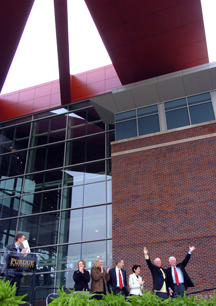 |
"This building represents a physical and intellectual gateway to the College of Engineering," said Leah Jamieson, Purdue's John A. Edwardson Dean of Engineering. "Having materials engineering and aeronautics and astronautics under the same roof reflects engineering's reach from the nanoscale to the galactic. As home to engineering education and the first-year engineering program, it represents the entry point to Purdue's College of Engineering and our commitment to continually advancing knowledge about how people learn engineering. Being home to our nationally acclaimed Minority Engineering Program and Women in Engineering Program emphasizes the relationship between diversity and innovation. And as home to EPICS, it shines a light on the connections between engineering and society."
Contemporary building reflects mission and memories
The building's distinctive winglike roof extensions are part of a design that mimics the appearance of an aircraft to symbolize Purdue's contributions to flight and the space program. One of the wings, sheathed in metallic panels, hangs over the entrance and a sculpture of Armstrong. Purdue officials, working with Ratio Architects in Indianapolis, attempted to create a design that would be distinctively modern, yet would not clash with surrounding structures.
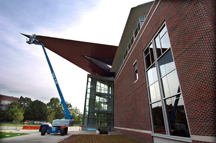 |
Conduits, ductwork, pipes for the chilled-water air conditioning system and other mechanical elements are exposed in the ceiling to provide a sense of engineering's role in the vital functions of a building.
Walkways inside the building look down on an expansive atrium, which has a 53-foot-high ceiling. Hanging in the atrium will be a replica of the Apollo 1 command module identical to the one in which Roger Chaffee, Virgil "Gus" Grissom and Ed White died in 1967. The replica is being loaned to Purdue by the Kansas Cosmosphere and Space Center.
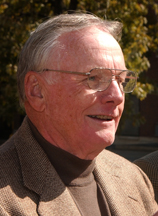 |
Neil Armstrong Hall, built by Smoot Construction LLC of Indianapolis, has a gross square footage of 210,326 feet, including 126,441 square feet for teaching, research and administrative-offices on four floors, including a lower level. Of this space, more than 20,000 square feet is dedicated for research labs and 60,000 square feet for undergraduate teaching facilities, including discipline-specific design labs and "learning modules." The modules are intended to facilitate student teamwork, one of the most important facets of engineering education, Jamieson said.
"Team learning modules provide laboratories where students see how all the disciplines involved in a project interact," Jamieson said. "They also help us prepare students for real-world working environments."
A bronze sculpture of Armstrong, looking pensive and studious as an undergraduate in the 1950s, sits on a stone plinth in front of the building. His right hand rests on a small stack of books, and his slide rule is removed from its case as though ready for action.
"I feel that the final product hit the required note perfectly well," said Eugene R. Hatke, senior architect in Purdue's Office of the University Architect. "It is very respectful of the campus around it, but, in detail, it is clearly contemporary."
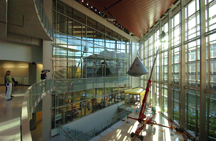 |
Neil Armstrong Hall also pays tribute to another Apollo astronaut: Chaffee, a Purdue alumnus who was killed in 1967 along with alumnus Grissom and White while training for the Apollo I mission. A curving 50-foot-long, floor-to-ceiling "exhibitry" near the atrium on the first floor will house a photomural of Chaffee's life. In the center of the mural is a display of a lunar sample collected during the Apollo 17 mission commanded by Eugene Cernan, a Purdue alumnus and the last astronaut to walk on the moon. The sample, on loan from NASA, was provided by Chaffee's widow, Martha Chafee.
The Chaffee mural will be on display for about a year. Fall 2008 will see the installation of an interactive exhibit aimed at audiences including elementary school children, alumni, groups and scholars from various disciplines.
"The exhibit will use the state-of-the-technology to emphasize the role of engineering in addressing societal grand challenges as well as the leadership role that Purdue engineering is playing in this arena," Jamieson said
A few select classes and labs currently are meeting in the building, which was completed in September and will be in full use beginning in January. In the meantime, faculty members are moving their labs and offices into the building.
School of Aeronautics and Astronautics
The new labs and facilities will foster team-based learning and an educational approach in which students learn the entire "design-build-test" process, as advised by the school's Industrial Advisory Council, said Thomas Farris, head of the School of Aeronautics and Astronautics.
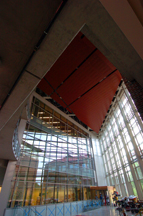 |
The building houses a new zero-gravity lab for research led by Steven Collicott, a professor of aeronautics and astronautics who moved the lab from its previous location at the Purdue Airport. The laboratory enables researchers and students to conduct experiments in the absence of gravity, recreating the weightlessness and microgravity environments of space. Upgrades in the new lab will enable Collicott to improve his research and teaching activities, installing a 64-foot-tall drop tower that provides 2 seconds of weightlessness for experiments.
"This will be much better than my previous tower, which produced in most cases only 0.8 second of data," Collicott said. "I'm already receiving requests from researchers and satellite engineers asking how soon they can come to Purdue to use the new tower."
The zero-gravity experiments will help create better designs for fuel tanks, life support systems and other spacecraft systems that contain fluids. Learning more about the physics of fluid movement also could help researchers improve designs for earthbound applications such as mist inhalation devices for medicine, fuel cells and "laboratory-on-a-chip" microdevices that rely on liquids, said Collicott, who operated an experiment on the International Space Station this year to study how fluids flow in the absence of gravity.
The team learning modules will benefit students competing for NASA's Reduced Gravity Student Flight Opportunity Program. Undergraduate students selected by NASA to participate in the program conduct experiments in zero-gravity conditions induced inside an aircraft as it flies in parabolic maneuvers. The students design their experiments in courses taught by faculty members in engineering and other fields, a tradition started by Collicott 12 years ago.
Laboratory spaces in the new building accommodate classes of 12-20 students. Since many laboratory courses include discussion and lecture components, the labs include space for teaching and group presentations.
School of Materials Engineering
Most of the teaching and research facilities are on the second floor. The lower level houses a "vastly improved electron microscopy" facility, which will consolidate microscopes operated by materials engineering and aeronautics and astronautics, said Alex King, head of the School of Materials Engineering.
The lower level also houses powerful hydraulic equipment used by both schools to push materials to their limits by bending, pulling, compressing and shaking specimens until they fail. The research is aimed at both learning more about existing materials and developing new materials.
Neil Armstrong Hall will enable the School of Materials Engineering to increase its undergraduate enrollment to 125 from the current 107 and raise its graduate enrollment to 90 students from the current 55. Faculty size has already doubled to 22 since 2000 to accommodate the increasing student numbers and to position the school as a leader in materials research, particularly in the fields of processing, manufacturing and nanoscale technology, King said
"It's going to be a huge improvement," he said. "Bettering the electron microscopy facility, the building also will contain a new lab for polymer synthesis, an entirely new capability for us, and new computer machine rooms."
One of the most dramatic improvements is the increase in space and resources for graduate students.
"We used to have only two high-quality microscopes for students to look through during class," King said. "Now we have an entirely new lab with enough microscopes for every student to look through while the teacher is lecturing. This was made possible by a generous discount from one of the leading equipment providers, LECO Corp., of St. Joseph, Mich."
In the previous facility, materials engineering students watched on a large screen as the instructor lectured about specimens under a microscope. The new facility contains 14 new optical microscopes for metallurgical studies, each equipped with a computer and monitor. The microscopes are worth up to $30,000 apiece.
The building also creates synergies between materials engineering and aeronautics and astronautics because of the shared electron microscopy, mechanical testing and computer facilities, King said.
"The machine room will contain an array of microprocessors functioning as one computer, like having several personal computers all working together," King said. "This sort of operation generates a lot of heat, and until now we have not had a proper space for these computers."
Department of Engineering Education, EPICS, Minority Engineering, Women in Engineering
Neil Armstrong Hall will help Purdue lead the nation in developing a new strategy and agenda for training future generations of engineers who will be better able to compete in the global work force, said Kamyar Haghighi, head of the Department of Engineering Education, the first of its kind in the world.
Researchers in the department are working to discover how students learn engineering concepts. The new focus is geared toward developing more effective engineering curricula and learning environments and encouraging more young people to pursue engineering careers.
"We are turning engineering education into a scientific scholarly endeavor so that we can determine fundamentally how students learn engineering concepts," Haghighi said.
The department's team learning module, called the "ideas to innovation learning laboratory," will provide an ideal space for students to collaborate on projects from concept to completion.
"Our incoming students will be welcomed and advised during that crucial freshman year in ways that will equip them to move into the particular engineering school they choose," Haghighi said. "Now, we have designed learning environments that can be optimized for teaching."
Team-focused, collaborative spaces will prepare students for engineering careers by teaching them how the field is practiced as a global profession.
"Engineering is a social exercise - people coming together to create products and processes that profoundly better the lives of individuals around the world," Haghighi said. "The Department of Engineering Education's learning laboratory will offer design-based, experiential-learning opportunities in flexible spaces that support and encourage collaborative work."
Glass-walled labs in the building provide an integrated learning space to showcase programs for touring prospective students, alumni and other visitors.
"People are going to see things they would not have ordinarily thought of as engineering," said EPICS director William Oakes. "Right now in our lab there are stuffed animal toys that are being animated for children's clinics. There are interactive sensory walls and maps for children with disabilities. There is a baby stroller being modified for medical applications so that it can easily be equipped with respirators and other medical devices for children. Seeing these kinds of projects will broaden the experience for early engineering students."
The building's innovative design will help the Minority Engineering Program showcase its activities, as well.
"It's going to provide outreach opportunities for us as we work with students and interact with alumni," said Virginia Booth-Gleghorn, director of Purdue's Minority Engineering Program. "It's also a center for strengthening connections with precollege students, current students, alumni, corporate partners and our community."
Purdue's Women in Engineering program will reap similar benefits, said program director Beth Holloway.
"Because one of our main goals is to reach young women as soon as possible, having visible space in the building that serves as the gateway to engineering is critical," Holloway said. "The building spaces emphasize team learning and the creative process - clearly important aspects of educating engineers for the 21st century - and those are aspects of engineering that tend to appeal to young women."
Dedication details
The event has drawn together the largest group of Purdue's alumni astronauts since 1999 when all 19 still living were reunited. Since then, another Purdue graduate has joined the group.
In addition to Armstrong, space alumni who have confirmed their visit to Purdue are John Blaha, Mark Brown, Eugene Cernan, Richard Covey, Drew Feustel, Greg Harbaugh, Michael McCulley, Gary Payton, Mark Polansky, Jerry Ross, Loren Shriver, Janice Voss, Charles Walker, Don Williams and David Wolf.
Armstrong, commander of Apollo 11 and Gemini-Titan VIII, earned a bachelor's degree from Purdue in aeronautical and astronautical engineering in 1955.
Blaha, who earned his master's degree in aeronautical engineering from Purdue in 1966, has flown on six Space Shuttle missions, the last in 1997.
Brown, who earned his bachelor's degree in aeronautical and astronautical engineering in 1973, has flown on two shuttle missions, the last in 1991.
Casper, who earned his master's degree in astronautics in 1967, has flown on four shuttle missions, the last one in 1996.
Cernan, who earned his bachelor's degree in electrical engineering in 1956, was a member of the Apollo 10 and Apollo 17 crews, as well as the Gemini-Titan IX-A crew. He was the last man to walk on the moon.
Covey, a 1969 graduate with a master's degree in aeronautical and astronautical engineering, flew on four shuttle missions, the last one in 1993.
Feustel, who earned his bachelor's and master's degrees in earth and atmospheric sciences in 1989 and 1991, respectively, is slated to fly a Space Shuttle mission next year that will service the Hubble Space Telescope.
Harbaugh, a 1978 graduate with a bachelor's degree in aeronautical and astronautical engineering, has flown on four shuttle missions, the last one in 1997.
McCulley, who earned his bachelor's and master's degrees in metallurgical engineering in 1970, flew on one space shuttle mission in 1989.
Payton earned his master's degree in aeronautical and astronautical engineering in 1972 and participated in a 1985 shuttle mission.
Polansky earned his bachelor's and master's degrees in 1978 in aeronautical and astronautical engineering and participated in two shuttle flights, the last in 2006.
Ross earned his bachelor's degree in 1970 and his master's degree in mechanical engineering in 1972 and has flown on seven shuttle missions, the last one in 2002.
Shriver, who earned his master's degree in aeronautical engineering in 1968, was on three shuttle missions, the last in 1992.
Voss, who earned her bachelor's degree in engineering sciences in 1975, has flown on five shuttle missions, the last one in 2000.
Walker, a 1971 graduate with a bachelor's degree in aeronautical and astronautical engineering, has flown on three space shuttle missions, the last one in 1985.
Williams, who earned his bachelor's degree in mechanical engineering in 1964, flew on two shuttle missions, the last in 1989.
Wolf, who earned his bachelor's degree in electrical engineering in 1978, participated in three shuttle missions, the last in 1998.
About Neil Armstrong
Armstrong earned a bachelor's degree from Purdue's School of Aeronautics and Astronautics in 1955 and was selected for astronaut training in 1962. As spacecraft commander for NASA's Apollo 11, he and astronauts Michael Collins and Buzz Aldrin completed the first landing mission to the moon in 1969, when Armstrong was the first human to walk on the lunar surface.
He also was commander of the Gemini 8 flight in 1966 when he performed the first successful docking of two vehicles in space, flew 78 combat missions from an aircraft carrier during the Korean War and was a test pilot for pioneering high-speed aircraft.
Armstrong is a retired chairman of the EDO Corp., an electronics and aerospace manufacturer.
Funding for the building
The building was paid for with $37.7 million in state funds, and the balance came from private donors, including Caterpillar Inc.; the John Deere Foundation; and Purdue alumni Stephen D. Bechtel Jr., the late Kenneth O. Johnson, and Heddy Kurz, whose late husband was a Purdue alumnus.
Mary Jo Kirk and her husband, Purdue alumnus Bob Kirk of Washington, D.C., donated the money for the sculpture. In recognition, the area where it is located has been named Kirk Plaza.
The educational, interactive exhibit to open in 2008 will be made possible by a $1 million gift from the John Deere Foundation.
About the Purdue College of Engineering
Purdue's College of Engineering is made up of 14 academic programs: aeronautics and astronautics, agricultural and biological, biomedical, chemical, civil, construction engineering and management, electrical and computer, engineering education, industrial, materials, mechanical, nuclear, engineering professional education, and ecological engineering.
Purdue's College of Engineering includes more than 6,400 undergraduate students and almost 2,500 graduate students.
The new facility is part of the college's plan to increase the size of the engineering complex by 60 percent and improve existing facilities for teaching, research and engagement.
Writers: Emil Venere, (765) 494-4709, venere@purdue.edu
Sources: France A. Córdova, (765) 494-9708
Leah H. Jamieson, John A. Edwardson Dean of Engineering, (765) 494-5346, lhj@purdue.edu
Thomas N. Farris, head of the School of Aeronautics and Astronautics, (765) 494-5117, farrist@purdue.edu
Kamyar Haghighi, head of the Department of Engineering Education, (765) 494-3884, haghighi@purdue.edu
Alexander King, head of the School of Materials Engineering, (765) 494-4100, alexking@purdue.edu
Beth Holloway, Director, Women in Engineering, (765) 494-3889, holloway@purdue.edu
Purdue News Service: (765) 494-2096; purduenews@purdue.edu
PHOTO CAPTION:
Purdue President France A. Córdova, from left, and former Apollo astronauts Neil Armstrong and Eugene Cernan, listen to speakers during Saturday's (Oct. 27) dedication of the Neil Armstrong Hall of Engineering. Armstrong and Cernan, the first and last men to walk on the moon, joined 14 other astronauts and former astronauts who are Purdue alumni at the dedication ceremony. (Purdue News Service photo/Dave Umberger)
A publication-quality photo is available at https://www.purdue.edu/uns/images/+2007/armstrong-dedication.jpg
PHOTO CAPTION:
Purdue Former Apollo astronauts Neil Armstrong and Eugene Cernan, hands raised, take part in Saturday's (Oct. 27) ceremony to dedicate Purdue's Neil Armstrong Hall of Engineering. Armstrong and Cernan, the first and last men to walk on the moon, joined 14 other astronauts and former astronauts who are Purdue alumni at the dedication ceremony. The $53.2 million building is being haled as a gateway to engineering research and education. The building's distinctive winglike roof extensions are part of a design that mimics the appearance of an aircraft to symbolize Purdue's contributions to flight and the space program. (Purdue News Service photo/Dave Umberger)
A publication-quality photo is available at https://www.purdue.edu/uns/images/+2007/armstrong-dedication-wave.jpg
PHOTO CAPTION:
Construction workers put the finishing touches on a winglike roof extension on Purdue's $53.2 million Neil Armstrong Hall of Engineering. The building's distinctive wings are part of a design that mimics the appearance of an aircraft to symbolize Purdue's contributions to flight and the space program. (Purdue News Service photo/David Umberger)
A publication-quality photo is available at https://www.purdue.edu/uns/images/+2007/armstrong-wing.jpg
PHOTO CAPTION:
PHOTO CAPTION:
Construction is complete on Purdue's $53.2 million Neil Armstrong Hall of Engineering. Walkways inside the building look down on an expansive atrium, which has a 53-foot-high ceiling. Hanging in the atrium will be a replica of the Apollo 1 command module identical to the one in which Roger Chaffee, Virgil "Gus" Grissom and Ed White died in 1967. (Purdue News Service photo/David Umberger)
A publication-quality photo is available at https://www.purdue.edu/uns/images/+2007/armstrong-atrium.jpg
To the News Service home page
If you have trouble accessing this page because of a disability, please contact Purdue News Service at purduenews@purdue.edu.
